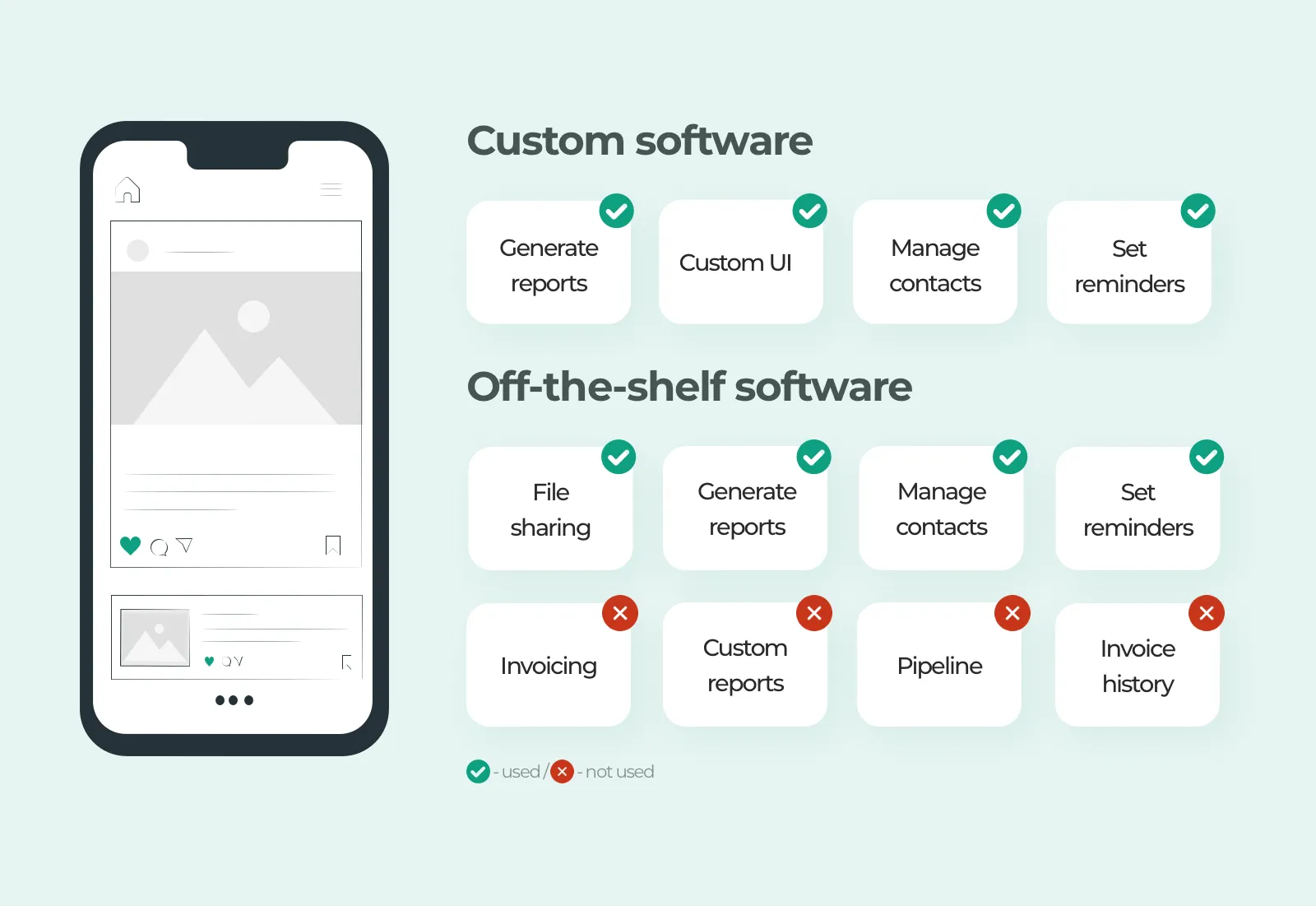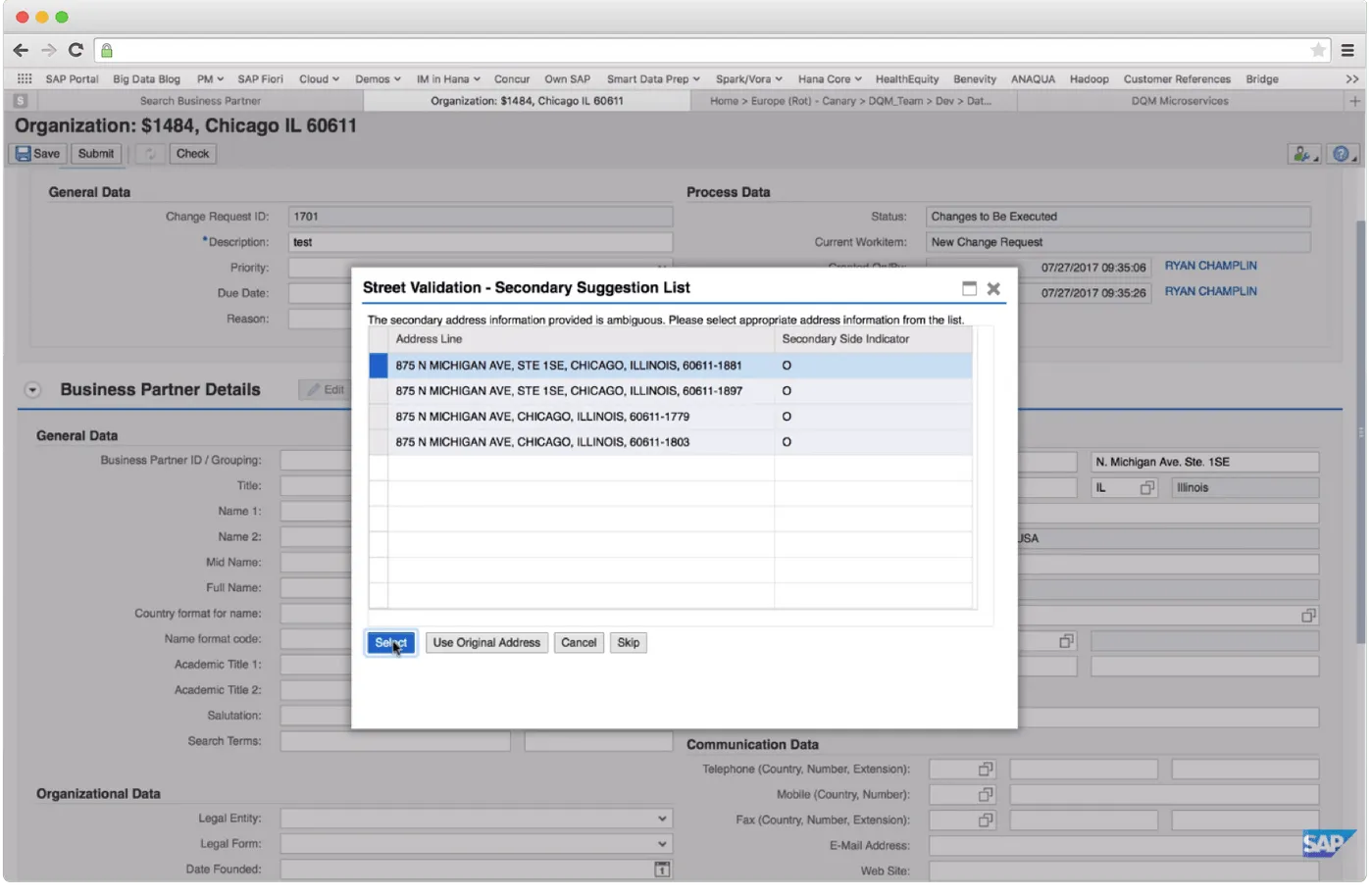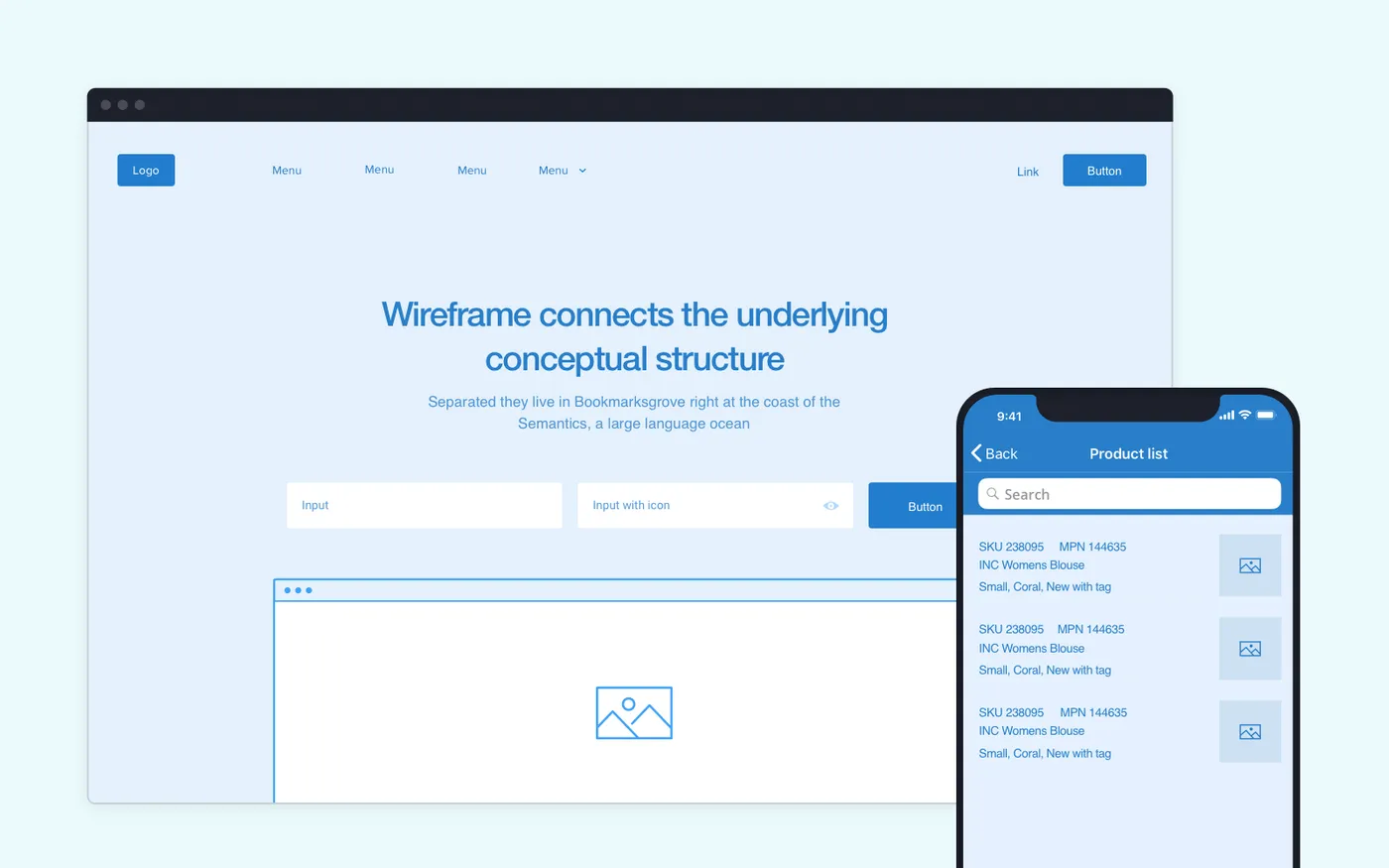Custom Software Development: What Is and When Do Companies Need It?
Updated 26 Aug 2023
11 Min
2565 Views
As your business grows, you'll face the need to automate established work processes sooner or later. Automation makes it easier to work with systems installed and results in increasing labor efficiency and profits.
To automate finance and accounting, inventory management, project management, and other vital processes, companies need to use the right software—CRM, ERP, HRM, and other systems.
For business owners, it's often a choice between using a ready-made IT solution or developing custom software.
This article discusses the benefits of custom software development for companies: what to expect from it, what pros and cons it brings, and when off-the-shelf solutions may be a better option.
What Is Custom Software Development?
Custom software development (also called bespoke) stands for creating digital products like mobile, web, and desktop apps for specific users or companies.
Let’s imagine you run a warehouse company and you need a mobile application to help employees navigate between the racks and move goods faster.
The custom app you’re making is designed to help with specific tasks: moving goods and navigating between the racks. And it’s made for specific users—your company's employees, not just any warehouse workers.
On the contrary, off-the-shelf software is designed to appeal to the broadest possible group of buyers and stakeholders. That’s how software creators return the development expenses—by making the app cater to as many users as possible.

The difference between ready-made vs. custom developed software: custom has only required features
A ready-made application may lack the features you need but have the ones you don’t require. This could mean you’re paying a fee to use just a couple of features while others stand idle.
Same if you have specific requirements for the product’s UI design. For example, you’re making a healthcare app for people with health issues like color blindness or low vision.
There's a high need for custom, inclusive UI/UX design. Not many corporate software makers can brag about their products being inclusive.
Making a custom product means making whatever app or website you like, with your corporate colors, icons, and other elements from the brand book. This product is designed specifically for your internal or external users to meet their specific needs.
Here are the most common types of internal custom software:
- CRM systems
- ERP systems
- Accounting software
- HRM/onboarding software
- Task management software
- Marketing management tools
- Business Intelligence (BI) tools
- Industry-specific solutions (like Electronic Health Records in healthcare)
To create a custom web or mobile app, you need to do research first. As it's an internal software, talk to employees, check the reports and statistics. That'll help you figure out what features and functionality the product should have.
Here’s how custom software is usually made:
- Research. Define the business goals, explore current solutions and their functionality, conduct user research.
- Planning. Identify the feature set, document project requirements, create wireframes.
- UI/UX design. Designing the product screen-by-screen.
- Software engineering. Writing code, testing, and debugging.
- Release and maintenance. Publishing mobile apps on app stores, publishing web apps, continuous bug-fixing and upgrades.
We’ve covered the full software development process from planning to release in another article. Check it out for more details
Custom Software vs. Off-the-Shelf Products
Of course, not all businesses need custom-developed software.
Out-of-the-box solutions work well for organizations with streamlined business processes and new companies just beginning to switch to the digital model.
In case you own a small company or startup and Google Spreadsheets, Excel, or a ready-made CRM do an excellent job for you, there's little sense in custom development.
But as your business grows, you'll face restrictions and limitations set by the software creators. For example, your out-of-box CRM may lack integrations with Slack, Dropbox, or other popular services.
There are two ways to solve this:
- Hire developers to see if the CRM can be customized or integrated with third-party services.
- Do not use Slack, Dropbox, or other unsupported tools with your CRM.
Instead of using software that caters to your business, you'll find yourself making business processes cater to the software functionality.
In the long run, there will be a moment when it's impossible to continue using the out-of-the-box software.
The result is time and money spent on the wrong product and lagging behind competitors that chose the custom-built path from the very beginning.
Even extensive solutions like Salesforce, SAP, Hubspot need developers to adapt them to specific companies. They'll have to create many forms, modules, components and use different APIs to make the software work for you.
At best, there would be half of the basic functionality that'll remain from the product.
| Criteria | Ready-made software | Custom software |
Functionality | Limited | Depends on the project |
Flexibility |
|
|
Launching time | Depends on the task | Usually fast |
Costs | Lower in the short term | Lower in the long term |
Security | High-level | Not fully secure |
Maintenance | Done by your tech vendor or any other software dev firm | Need to engage third-party company |
How Do You Know It's Time for Custom Software Development?
When an off-the-shelf product is enough:
- You have a basic workflow (for example: get a delivery request — register it, — send goods — print the necessary documents — finish).
- You have already worked with specific software and built processes based on your previous experience.
- The company is ready to put up with the limited functionality of ready-made software.
- There’s no extra money, time, or both to spend on custom development.
When it's better to go for a custom solution:
- You need to control reporting taking into account the specifics of your business.
- Off-the-shelf software does not fit your company’s business processes.
- You want the software to be functional, with up-to-date and understandable UI design.
- There's a need to integrate the software with other services or extended APIs.
Benefits of Custom Software Development
Let’s take a closer look at both pros and cons of making your own software from scratch.
Saves Money in the Long Run
Custom development costs a lot, but in some cases, it's still cheaper than using an off-the-shelf platform. With custom software, you pay only for the features you're going to use.
If you go for ready-made solutions, you pay subscription fees for all the features, whether you need them or not. And you pay as long as you use the software, potentially forever.
For example, a popular FreeAgent CRM costs $250/user per month (unlimited suite). That's $3,000/year just for one employee.
If you have a team of at least 50 employees, it'll cost you $150,000/year.
It takes around 1,850h to build and costs ~$92,500 (Ukraine, Eastern Europe) to create CRM basic software.
In general, custom CRM costs may vary from $30,000 to $300,000 and up. The total sum depends on your product’s complexity, the region where you hire developers, and their qualifications.
Easy to Scale and Plan for Updates
Customization isn't always an option with ready-made software. Even if you request to update a feature or fix a bug, it can take years and hundreds of other unsatisfied clients to make it a priority. And if you place a customization request, it'll cost you some.
With custom software, you may start from core features, make sure everything is working right. Then, add new features or integrate the software with other services.
Less Time Spent on Staff Training
Off-the-shelf products may require more time to get to know all the bells and whistles. Then figure out which ones you don't need to use. Same with training your employees to use the software.
For example, training is a common problem for companies that implemented SAP (a popular enterprise platform). It completely changes the way a company does business, is expensive, requires extensive training, and is very hard to learn to use.

SAP quality management module
You need to hire SAP (ABAP) developers to integrate the software via APIs and SAP consultants to advise you on customizations.
Both SAP developers and consultants are very rare and very expensive. Indeed states that an ABAP developer in the United States charges $69.84 per hour of work on average. SAP consultants charge a bit more—**$75.30/hour**.
Bespoke software development is aimed to fit your business and serve your specific goals. It only includes the features and integrations you've asked for, nothing extra.
Engineered Around Your Security Requirements
Security is critical for software that deals with finances, stores personal client data, or has some regulations to meet (GDPR or HIPAA).
For example, in the healthcare industry HIPAA violation (such as incorrect disposal of the information or data breaches) leads to severe consequences. The penalty is from $100 to $50,000 per violation.
There is no such thing as a one-size-fits-all solution to security. If you adopt off-the-shelf cloud services, you won't get the security that’s tailored to you.
Network firewall protection, access control, encryption algorithms, log records, automated log-off—these are just some of the security measures that can be used.
By choosing to develop custom software, you're free to apply any security measures required in your industry. Especially if you're working with a tech vendor who knows privacy regulations applicable to your sector.
And here are a few cons of custom-developed software:
High development costs
Software development is expensive, especially in regions like the USA, Canada, or Western Europe. In North America, companies charge $100-$150/hour, while in Western Europe from $50/hour to $150/hour.
If the local prices are too high for you, you can outsource software development to regions like Eastern Europe.
Check our comparison of software development costs in different regions, from North America to Asia.
Time consumption
Unlike ready-made software, custom products aren’t plug-and-play at all. They require time to develop.
Even if you're building a basic product with a simple UI and a couple of features, it could take months to research, plan, and develop it. While complex solutions with custom interface design, unique features, and integrations may take years to finish.
In case custom software pros work for you and your business, you should start considering the development options.
But if they don't seem to be a good idea for now, don't bother with it. Sometimes it's better to find a decent ready-made solution and customize it. Instead of spending a pretty penny on custom products only to find out you never needed them in the first place.
Things to Do Before Custom Software Development
A complex internal product can't be built in two weeks for two bucks. The more sophisticated your software is, the more time it'll take to analyze all the requirements, agree on UI/UX design, set up infrastructure, and so on.
Here’s what you can do before the development starts to speed things up:
1.Set Clear Project Goals
Before you start looking for companies that provide custom software development services, specify your budget and project requirements:
- Do you need web or mobile software? What platforms do you want to cover (web, iOS, Android, Windows)?
- What features do you want to include?
- How many people will be using the software?
- Does it need integrations with other services?
- Are you going to migrate data from your old app to the new one?
- Do you have any requirements for the product's UI/UX design?
The clearer are the goals, the easier it’ll be to define the features to implement first. This way, you avoid spending money on something that doesn’t directly solve your tasks.
You can start by creating lists of must-have and nice-to-have features. This will help your developers focus on the core functionality. Even if something—deadlines, unexpected bugs, or budgets—goes wrong, your team will achieve certain results.
2.Find Qualified Software Developers
You may already have an in-house IT or software team who can take care of the product development. Just make sure it won't impact the work they're doing on a daily basis.
If there are no available software engineers around, building a software development team (namely a dedicated one) is a perfect solution. Same in case your internal team doesn't have the time or skills to handle the development.
In case there are no local custom software engineers available or they charge too much, you can outsource the development to another country.
There are several popular outsourcing regions:
- Eastern Europe
- Central Europe
- Western Europe
- Latin America
- Asia
You can start searching for a team on platforms like Clutch or GoodFirms. There you can filter companies by location, industry, hourly rates, and check verified reviews from previous clients.
3.Get Acquainted With Custom Software Development Process
The development always starts with research and planning, then followed by UI design and software engineering.
It doesn't matter much if you're working with an in-house, outsourcing, or IT consulting company. You'll require a detailed specification, a clear development plan, and exact time estimates in both cases.
At Cleveroad, we prepare the following documentation:
- Project’s specification with tech, functional, and usability requirements, user stories, flowchart, and so on.
- Wireframe is important, as it's a schematic placement of elements on app screens to settle any design-related questions
- Rough and detailed project estimates with the number of hours needed to implement each feature

How mobile and web wireframes look like
Before you start custom software or application development, it’s always a good idea to consult an experienced tech vendor. They'll advise on techs and architecture design, provide the scalability and security roadmaps, make a rough estimation of time and costs.
At Cleveroad, we have Business Analysts who can help companies define their requirements, create a list of features, and prepare documentation. While our software architects will help to define the best technologies and tools for software engineering.
Need help with your software?
Our engineers provide tech consultations for free. Contact us, and tell us more about your project.
Custom software development stands for creating digital products—mobile, web, and desktop applications—for specific users or companies.
Making a custom product means making whatever app or website you like, with your corporate colors, icons, and other elements from the brand book. This product is designed specifically for your internal or external users to meet their specific needs.
Advantages of custom-made software over off-the-shelf products:
- Saves money on the long run
- Easy to scale and plan for updates
- Less time spend on staff training
- Engineered to meed your requirements
Here’s how custom software is usually made:
- Research. Define the business goals, explore current solutions and their functionality, conduct user research.
- Planning. Identify the feature set, document project requirements, create wireframes.
- UI/UX design. Designing the product screen-by-screen.
- Software engineering. Writing code, testing, and debugging.
- Release and maintenance. Publishing mobile apps on app stores, publishing web apps, continuous bug-fixing and upgrades.
Because it’s cheaper. Software development is expensive, especially in regions like the USA, Canada, or Western Europe. In North America, companies charge $100-$150/hour, while in Eatern Europe they charge from $25/hour to $50/hour.
Searching for a software development firm goes in three stages:
- Basic research. Take a look at the company's portfolio to find project similar to yours. You may also check what their clients say on platforms like Clutch or GoodFirms. Also, pay attention to their social media pages.
- Tech research. Pay attention to the technologies—programming languages, frameworks, libraries—they work with, their project management tools, and GitHub commits.
- Face-to-face meeting. A great way to learn more about their company’s business logic, security procedures, and everyday communication channels.

Evgeniy Altynpara is a CTO and member of the Forbes Councils’ community of tech professionals. He is an expert in software development and technological entrepreneurship and has 10+years of experience in digital transformation consulting in Healthcare, FinTech, Supply Chain and Logistics
Give us your impressions about this article
Give us your impressions about this article